Abstract
Patterns of illness in American children have changed dramatically in this century. The ancient infectious diseases have largely been controlled. The major diseases confronting children now are chronic and disabling conditions termed the "new pediatric morbidity"--asthma mortality has doubled; leukemia and brain cancer have increased in incidence; neurodevelopmental dysfunction is widespread; hypospadias incidence has doubled. Chemical toxicants in the environment as well as poverty, racism, and inequitable access to medical care are factors known and suspected to contribute to causation of these pediatric diseases. Children are at risk of exposure to over 15,000 high-production-volume synthetic chemicals, nearly all of them developed in the past 50 years. These chemicals are used widely in consumer products and are dispersed in the environment. More than half are untested for toxicity. Children appear uniquely vulnerable to chemical toxicants because of their disproportionately heavy exposures and their inherent biological susceptibility. To prevent disease of environmental origin in America's children, the Children's Environmental Health Network (CEHN) calls for a comprehensive, national, child-centered agenda. This agenda must recognize children's vulnerabilities to environmental toxicants. It must encompass a) a new prevention-oriented research focus; b) a new child-centered paradigm for health risk assessment and policy formulation; and c) a campaign to educate the public, health professionals, and policy makers that environmental disease is caused by preventable exposures and is therefore avoidable. To anchor the agenda, CEHN calls for long-term, stable investment and for creation of a national network of pediatric environmental health research and prevention centers.
Full text
PDF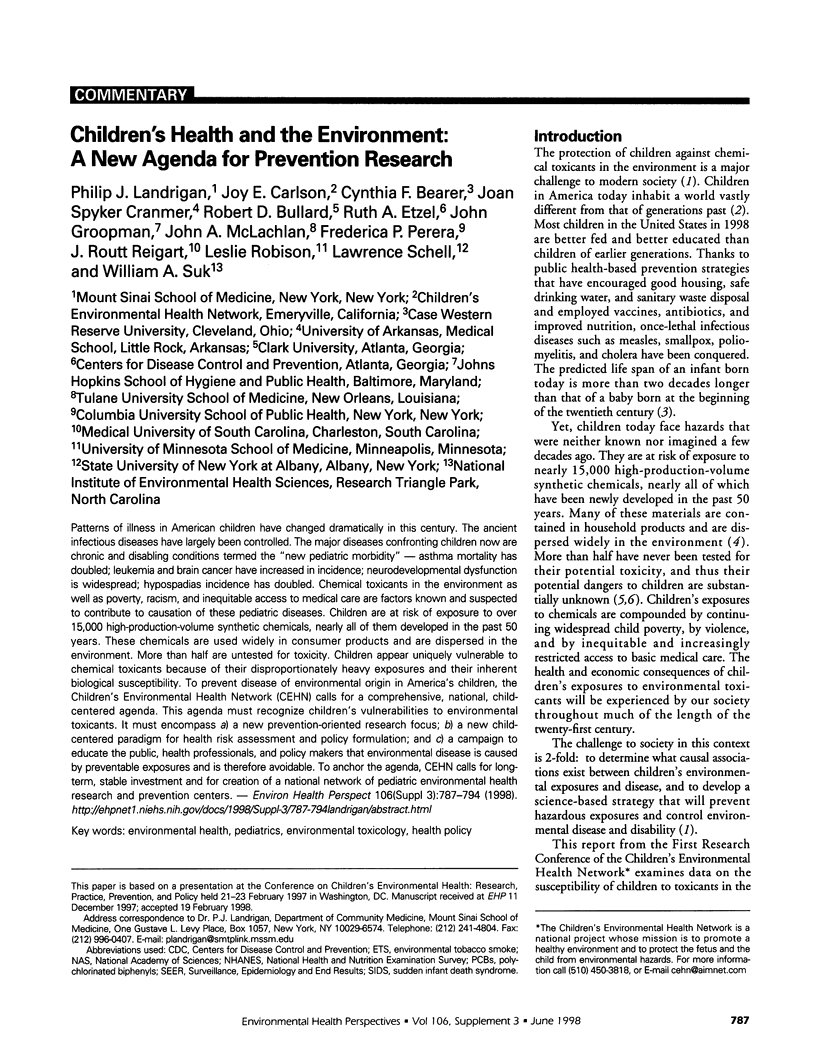
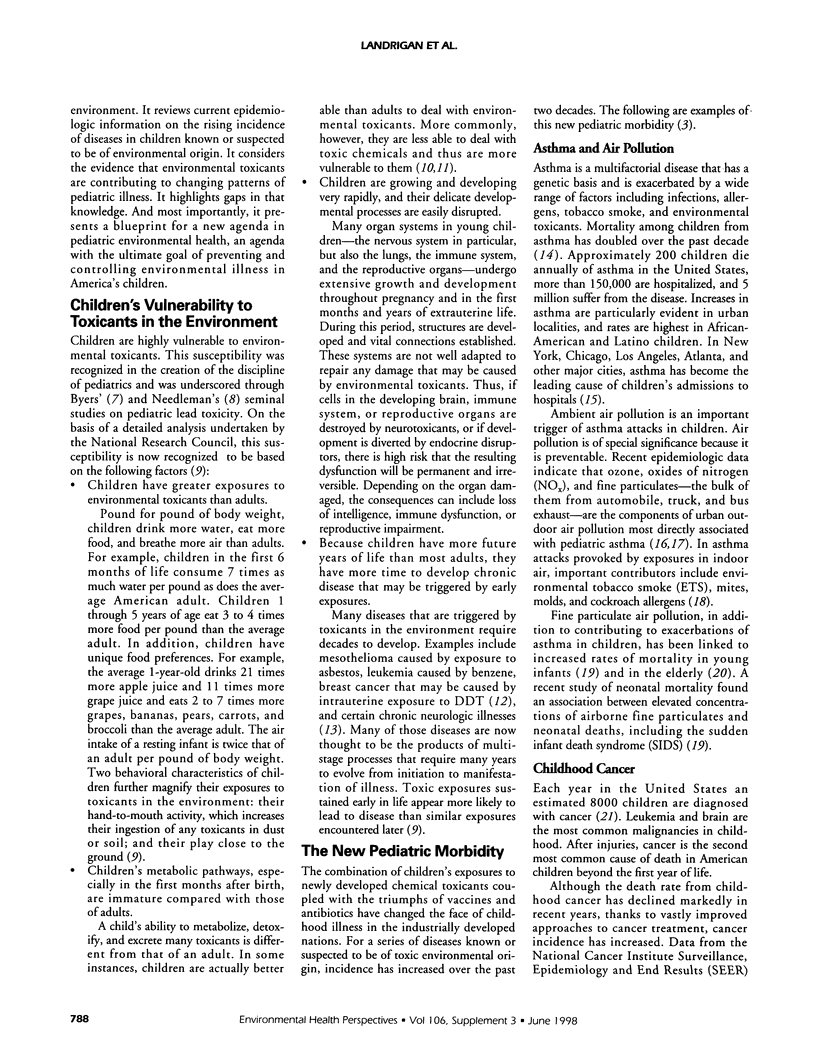
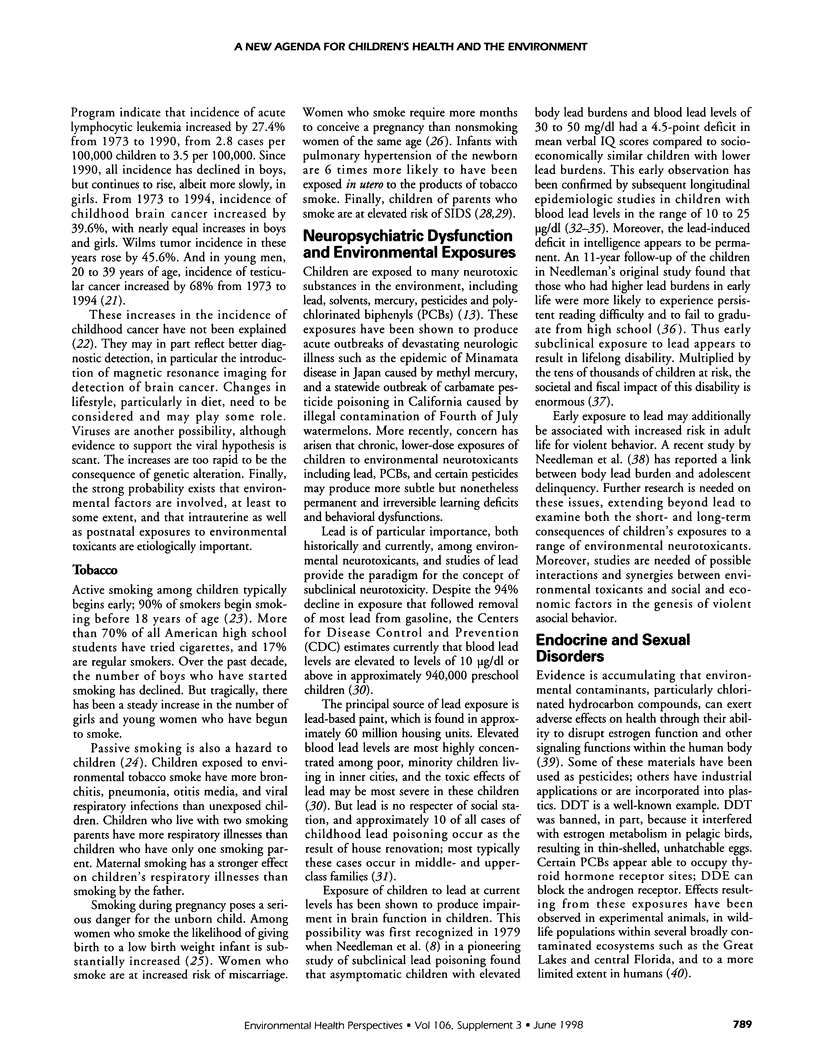
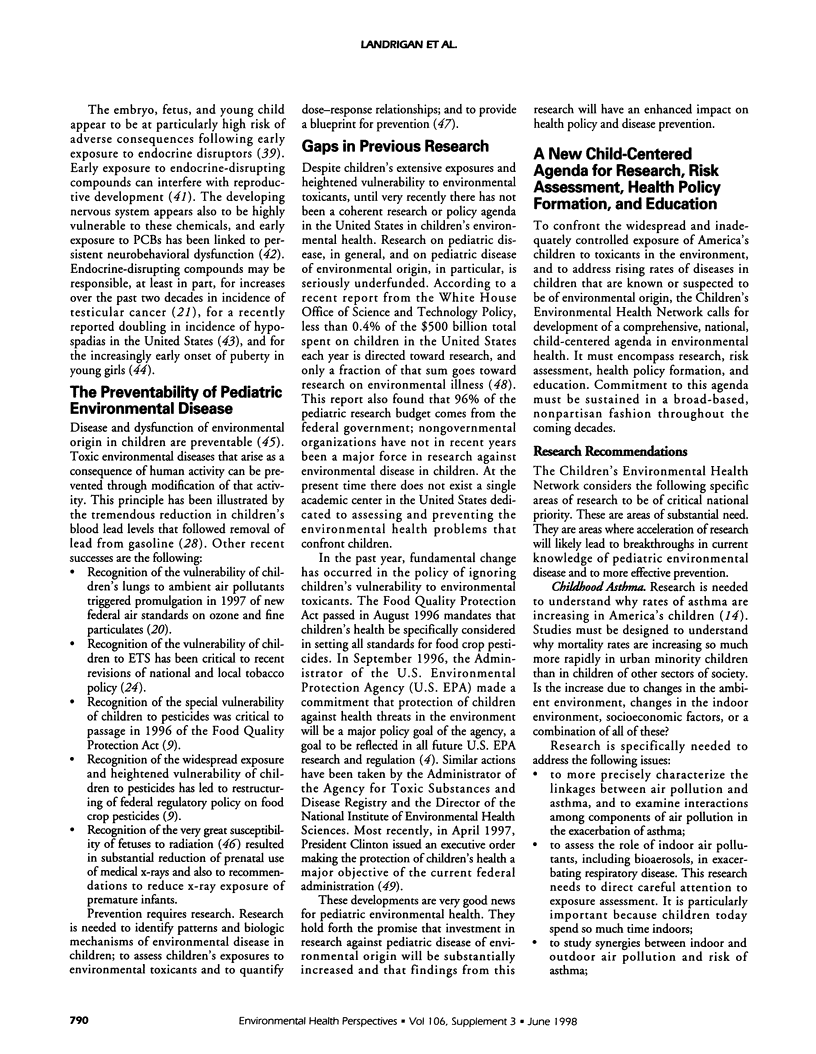
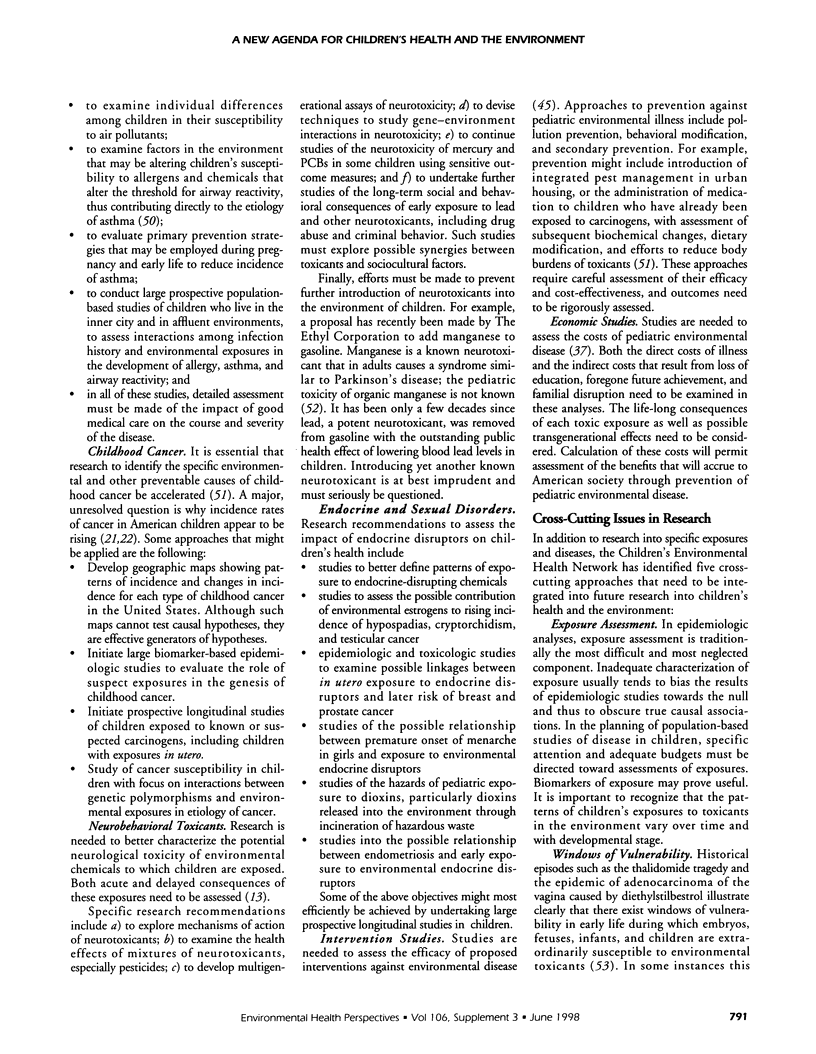
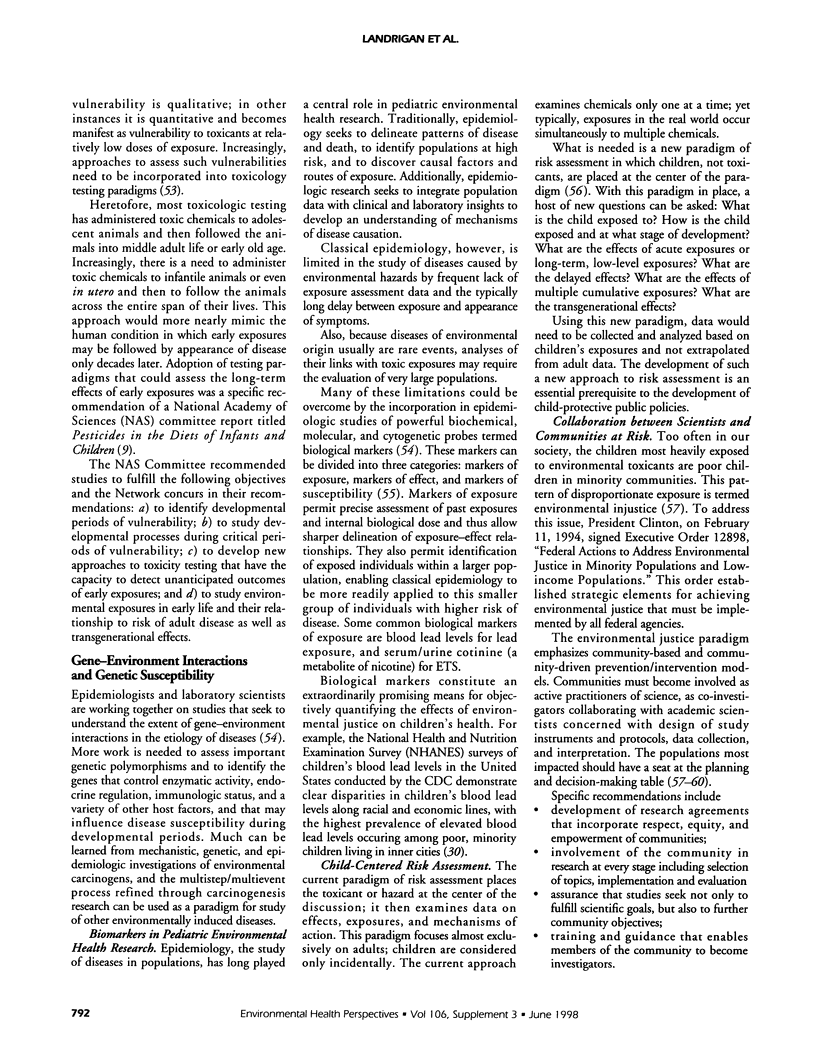
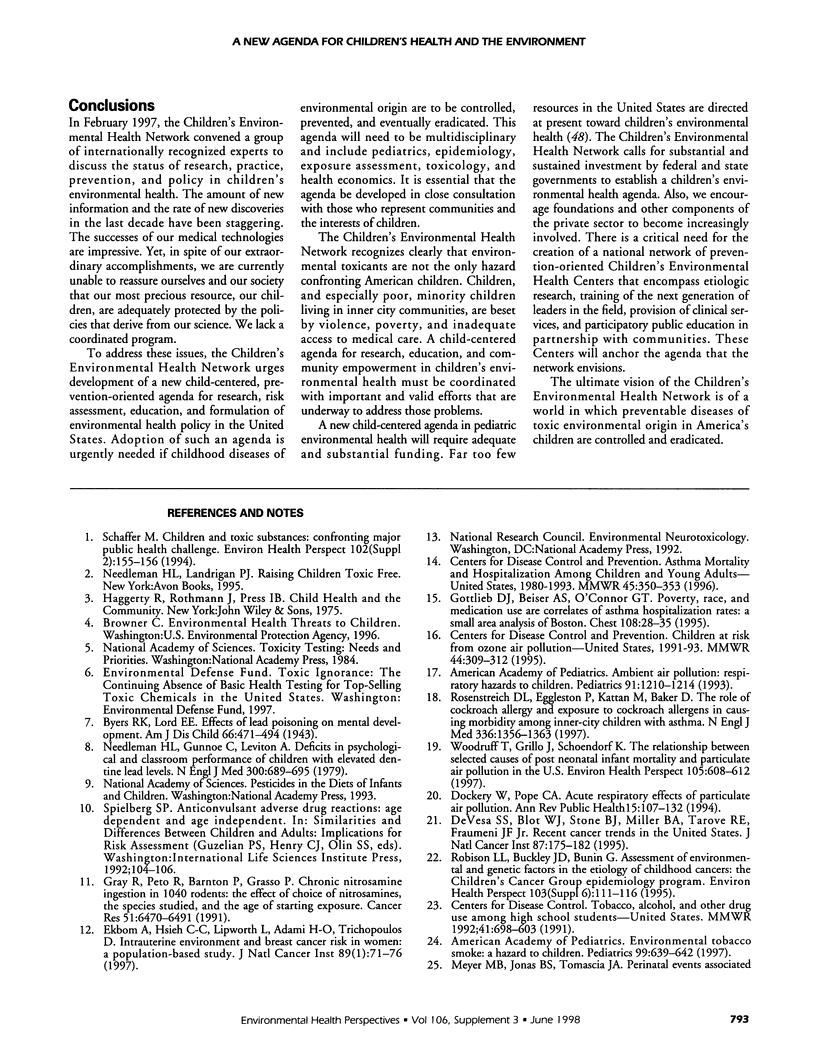
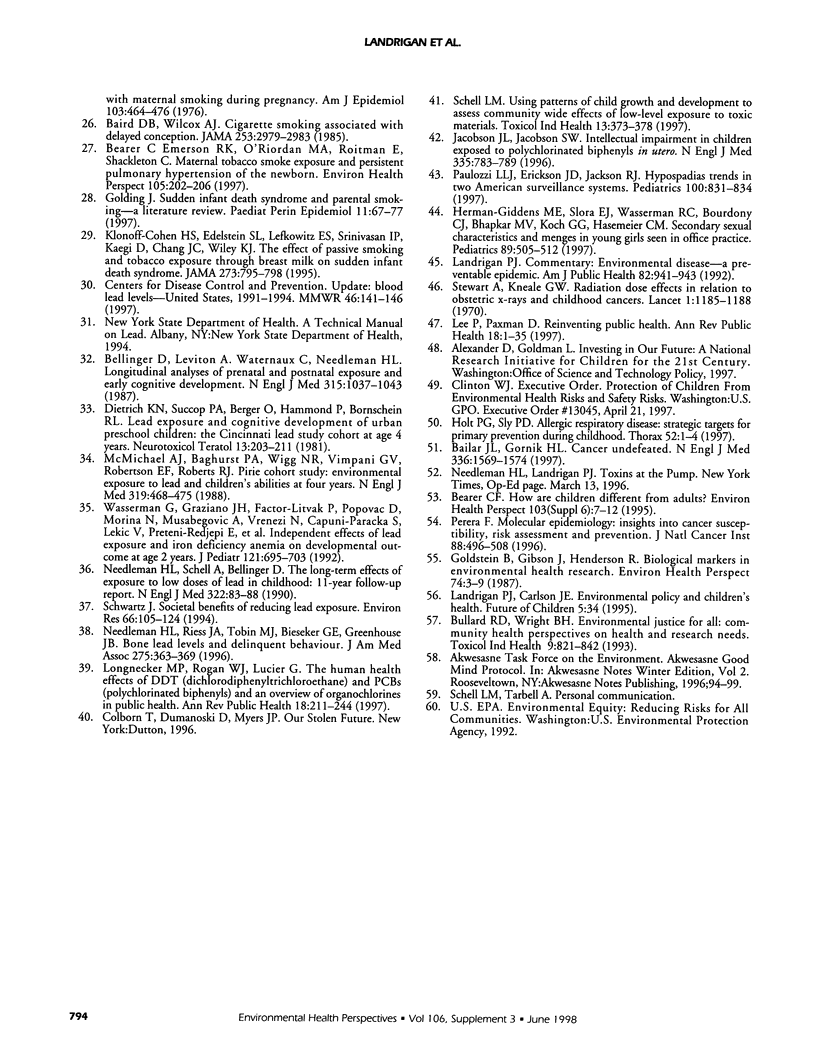
Selected References
These references are in PubMed. This may not be the complete list of references from this article.
- Bailar J. C., 3rd, Gornik H. L. Cancer undefeated. N Engl J Med. 1997 May 29;336(22):1569–1574. doi: 10.1056/NEJM199705293362206. [DOI] [PubMed] [Google Scholar]
- Baird D. D., Wilcox A. J. Cigarette smoking associated with delayed conception. JAMA. 1985 May 24;253(20):2979–2983. [PubMed] [Google Scholar]
- Bearer C. F. How are children different from adults? Environ Health Perspect. 1995 Sep;103 (Suppl 6):7–12. doi: 10.1289/ehp.95103s67. [DOI] [PMC free article] [PubMed] [Google Scholar]
- Bearer C., Emerson R. K., O'Riordan M. A., Roitman E., Shackleton C. Maternal tobacco smoke exposure and persistent pulmonary hypertension of the newborn. Environ Health Perspect. 1997 Feb;105(2):202–206. doi: 10.1289/ehp.97105202. [DOI] [PMC free article] [PubMed] [Google Scholar]
- Bellinger D., Leviton A., Waternaux C., Needleman H., Rabinowitz M. Longitudinal analyses of prenatal and postnatal lead exposure and early cognitive development. N Engl J Med. 1987 Apr 23;316(17):1037–1043. doi: 10.1056/NEJM198704233161701. [DOI] [PubMed] [Google Scholar]
- Biological markers in environmental health research. Committee on Biological Markers of the National Research Council. Environ Health Perspect. 1987 Oct;74:3–9. doi: 10.1289/ehp.74-1474499. [DOI] [PMC free article] [PubMed] [Google Scholar]
- Bullard R. D., Wright B. H. Environmental justice for all: community perspectives on health and research needs. Toxicol Ind Health. 1993 Sep-Oct;9(5):821–841. doi: 10.1177/074823379300900508. [DOI] [PubMed] [Google Scholar]
- Centers for Disease Control (CDC) Tobacco, alcohol, and other drug use among high school students--United States, 1991. MMWR Morb Mortal Wkly Rep. 1992 Sep 18;41(37):698–703. [PubMed] [Google Scholar]
- Centers for Disease Control and Prevention (CDC) Asthma mortality and hospitalization among children and young adults--United States, 1980-1993. MMWR Morb Mortal Wkly Rep. 1996 May 3;45(17):350–353. [PubMed] [Google Scholar]
- Centers for Disease Control and Prevention (CDC) Children at risk from ozone air pollution--United States, 1991-1993. MMWR Morb Mortal Wkly Rep. 1995 Apr 28;44(16):309–312. [PubMed] [Google Scholar]
- Centers for Disease Control and Prevention (CDC) Update: blood lead levels--United States, 1991-1994. MMWR Morb Mortal Wkly Rep. 1997 Feb 21;46(7):141–146. [PubMed] [Google Scholar]
- Devesa S. S., Blot W. J., Stone B. J., Miller B. A., Tarone R. E., Fraumeni J. F., Jr Recent cancer trends in the United States. J Natl Cancer Inst. 1995 Feb 1;87(3):175–182. doi: 10.1093/jnci/87.3.175. [DOI] [PubMed] [Google Scholar]
- Dietrich K. N., Succop P. A., Berger O. G., Hammond P. B., Bornschein R. L. Lead exposure and the cognitive development of urban preschool children: the Cincinnati Lead Study cohort at age 4 years. Neurotoxicol Teratol. 1991 Mar-Apr;13(2):203–211. doi: 10.1016/0892-0362(91)90012-l. [DOI] [PubMed] [Google Scholar]
- Dockery D. W., Pope C. A., 3rd Acute respiratory effects of particulate air pollution. Annu Rev Public Health. 1994;15:107–132. doi: 10.1146/annurev.pu.15.050194.000543. [DOI] [PubMed] [Google Scholar]
- Ekbom A., Hsieh C. C., Lipworth L., Adami H. Q., Trichopoulos D. Intrauterine environment and breast cancer risk in women: a population-based study. J Natl Cancer Inst. 1997 Jan 1;89(1):71–76. doi: 10.1093/jnci/89.1.71. [DOI] [PubMed] [Google Scholar]
- Golding J. Sudden infant death syndrome and parental smoking--a literature review. Paediatr Perinat Epidemiol. 1997 Jan;11(1):67–77. doi: 10.1046/j.1365-3016.1997.d01-12.x. [DOI] [PubMed] [Google Scholar]
- Gottlieb D. J., Beiser A. S., O'Connor G. T. Poverty, race, and medication use are correlates of asthma hospitalization rates. A small area analysis in Boston. Chest. 1995 Jul;108(1):28–35. doi: 10.1378/chest.108.1.28. [DOI] [PubMed] [Google Scholar]
- Gray R., Peto R., Brantom P., Grasso P. Chronic nitrosamine ingestion in 1040 rodents: the effect of the choice of nitrosamine, the species studied, and the age of starting exposure. Cancer Res. 1991 Dec 1;51(23 Pt 2):6470–6491. [PubMed] [Google Scholar]
- Herman-Giddens M. E., Slora E. J., Wasserman R. C., Bourdony C. J., Bhapkar M. V., Koch G. G., Hasemeier C. M. Secondary sexual characteristics and menses in young girls seen in office practice: a study from the Pediatric Research in Office Settings network. Pediatrics. 1997 Apr;99(4):505–512. doi: 10.1542/peds.99.4.505. [DOI] [PubMed] [Google Scholar]
- Holt P. G., Sly P. D. Allergic respiratory disease: strategic targets for primary prevention during childhood. Thorax. 1997 Jan;52(1):1–4. doi: 10.1136/thx.52.1.1. [DOI] [PMC free article] [PubMed] [Google Scholar]
- Jacobson J. L., Jacobson S. W. Intellectual impairment in children exposed to polychlorinated biphenyls in utero. N Engl J Med. 1996 Sep 12;335(11):783–789. doi: 10.1056/NEJM199609123351104. [DOI] [PubMed] [Google Scholar]
- Klonoff-Cohen H. S., Edelstein S. L., Lefkowitz E. S., Srinivasan I. P., Kaegi D., Chang J. C., Wiley K. J. The effect of passive smoking and tobacco exposure through breast milk on sudden infant death syndrome. JAMA. 1995 Mar 8;273(10):795–798. doi: 10.1001/jama.1995.03520340051035. [DOI] [PubMed] [Google Scholar]
- Landrigan P. J., Carlson J. E. Environmental policy and children's health. Future Child. 1995 Summer-Fall;5(2):34–52. [PubMed] [Google Scholar]
- Landrigan P. J. Commentary: environmental disease--a preventable epidemic. Am J Public Health. 1992 Jul;82(7):941–943. doi: 10.2105/ajph.82.7.941. [DOI] [PMC free article] [PubMed] [Google Scholar]
- Lee P., Paxman D. Reinventing public health. Annu Rev Public Health. 1997;18:1–35. doi: 10.1146/annurev.publhealth.18.1.1. [DOI] [PubMed] [Google Scholar]
- Longnecker M. P., Rogan W. J., Lucier G. The human health effects of DDT (dichlorodiphenyltrichloroethane) and PCBS (polychlorinated biphenyls) and an overview of organochlorines in public health. Annu Rev Public Health. 1997;18:211–244. doi: 10.1146/annurev.publhealth.18.1.211. [DOI] [PubMed] [Google Scholar]
- McMichael A. J., Baghurst P. A., Wigg N. R., Vimpani G. V., Robertson E. F., Roberts R. J. Port Pirie Cohort Study: environmental exposure to lead and children's abilities at the age of four years. N Engl J Med. 1988 Aug 25;319(8):468–475. doi: 10.1056/NEJM198808253190803. [DOI] [PubMed] [Google Scholar]
- Meyer M. B., Jonas B. S., Tonascia J. A. Perinatal events associated with maternal smoking during pregnancy. Am J Epidemiol. 1976 May;103(5):464–476. doi: 10.1093/oxfordjournals.aje.a112248. [DOI] [PubMed] [Google Scholar]
- Needleman H. L., Gunnoe C., Leviton A., Reed R., Peresie H., Maher C., Barrett P. Deficits in psychologic and classroom performance of children with elevated dentine lead levels. N Engl J Med. 1979 Mar 29;300(13):689–695. doi: 10.1056/NEJM197903293001301. [DOI] [PubMed] [Google Scholar]
- Needleman H. L., Riess J. A., Tobin M. J., Biesecker G. E., Greenhouse J. B. Bone lead levels and delinquent behavior. JAMA. 1996 Feb 7;275(5):363–369. [PubMed] [Google Scholar]
- Needleman H. L., Schell A., Bellinger D., Leviton A., Allred E. N. The long-term effects of exposure to low doses of lead in childhood. An 11-year follow-up report. N Engl J Med. 1990 Jan 11;322(2):83–88. doi: 10.1056/NEJM199001113220203. [DOI] [PubMed] [Google Scholar]
- Paulozzi L. J., Erickson J. D., Jackson R. J. Hypospadias trends in two US surveillance systems. Pediatrics. 1997 Nov;100(5):831–834. doi: 10.1542/peds.100.5.831. [DOI] [PubMed] [Google Scholar]
- Perera F. P. Molecular epidemiology: insights into cancer susceptibility, risk assessment, and prevention. J Natl Cancer Inst. 1996 Apr 17;88(8):496–509. doi: 10.1093/jnci/88.8.496. [DOI] [PubMed] [Google Scholar]
- Robison L. L., Buckley J. D., Bunin G. Assessment of environmental and genetic factors in the etiology of childhood cancers: the Childrens Cancer Group epidemiology program. Environ Health Perspect. 1995 Sep;103 (Suppl 6):111–116. doi: 10.1289/ehp.95103s6111. [DOI] [PMC free article] [PubMed] [Google Scholar]
- Rosenstreich D. L., Eggleston P., Kattan M., Baker D., Slavin R. G., Gergen P., Mitchell H., McNiff-Mortimer K., Lynn H., Ownby D. The role of cockroach allergy and exposure to cockroach allergen in causing morbidity among inner-city children with asthma. N Engl J Med. 1997 May 8;336(19):1356–1363. doi: 10.1056/NEJM199705083361904. [DOI] [PubMed] [Google Scholar]
- Schell L. M. Using patterns of child growth and development to assess communitywide effects of low-level exposure to toxic materials. Toxicol Ind Health. 1997 Mar-Jun;13(2-3):373–378. doi: 10.1177/074823379701300221. [DOI] [PubMed] [Google Scholar]
- Schwartz J. Societal benefits of reducing lead exposure. Environ Res. 1994 Jul;66(1):105–124. doi: 10.1006/enrs.1994.1048. [DOI] [PubMed] [Google Scholar]
- Stewart A., Kneale G. W. Radiation dose effects in relation to obstetric x-rays and childhood cancers. Lancet. 1970 Jun 6;1(7658):1185–1188. doi: 10.1016/s0140-6736(70)91782-4. [DOI] [PubMed] [Google Scholar]
- Wasserman G., Graziano J. H., Factor-Litvak P., Popovac D., Morina N., Musabegovic A., Vrenezi N., Capuni-Paracka S., Lekic V., Preteni-Redjepi E. Independent effects of lead exposure and iron deficiency anemia on developmental outcome at age 2 years. J Pediatr. 1992 Nov;121(5 Pt 1):695–703. doi: 10.1016/s0022-3476(05)81895-5. [DOI] [PubMed] [Google Scholar]
- Woodruff T. J., Grillo J., Schoendorf K. C. The relationship between selected causes of postneonatal infant mortality and particulate air pollution in the United States. Environ Health Perspect. 1997 Jun;105(6):608–612. doi: 10.1289/ehp.97105608. [DOI] [PMC free article] [PubMed] [Google Scholar]


